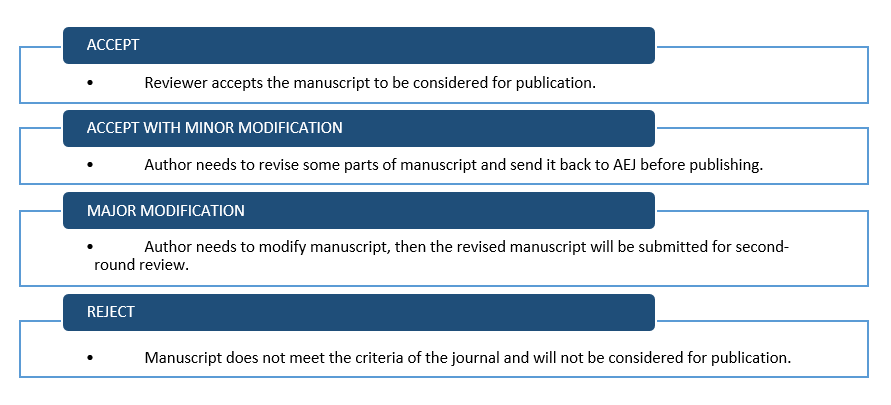Publication Policy
Editors are appointed by JICA PROJECT FOR AUN/SEED-Net and have an authority in selecting and shaping the content of the journal consistent with the approved coverage statement. Ultimate direction and publishing authority, however, belongs to the JICA PROJECT FOR AUN/SEED-Net. Responsibilities of Editors are explained below:
(1) Management of the Journal
Editors are expected to observe general policies and practices, as approved by JICA PROJECT FOR AUN/SEED-Net. Editors must ensure effective implementation of these policies and practices, as well as efficient management of the journal (e.g. in terms of maintaining editorial controls over lag times, rejection rates, timeliness of publication).
(2) Editors are responsible for all editorial matters, including:
(a) Selecting reviewers: Once a paper is submitted, JICA PROJECT FOR AUN/SEED-Net will forward to the Section Editor-in-Chief to nominate three reviewers under the responsible field. If any reviewer declines to review the paper within one week, the editor must propose the new reviewer to fulfill his/her place.
(b) Securing the copyright transfer: As a condition of publication, the transfer of allrights held under copyright by every contributor to JICA PROJECT FOR AUN/SEED-Net shall be done through Copyright Transfer agreement upon publication acceptance;
(c) Proofreading: Proofread all contributions in accordance with customary publishing standards, including English language accuracy and quality; in consultation with the JICA PROJECT FOR AUN/SEED-NET, furnishing final copy in production-ready format; and adhering to the page limits and editorial deadlines so that the journal is timely published.
(d) Ensuring that to the best of the editor’s knowledge nothing in the Journal violates any proprietary rights or copyright or is injurious or libelous.
(3) Section Editors-in-Chief will have complete authority to accept or reject manuscripts basedon the peer-review comments and recommendations. The decisions in this area are not subject to review by any officer of the JICA PROJECT FOR AUN/SEED-NET.
(4) Journal production is the responsibility of JICA PROJECT FOR AUN/SEED-NET. This responsibility includes but is not limited to copyediting style (punctuation, spelling, reference format, etc.), typography, cover design, front matter elements and arrangement, length of issue, and production schedules. JICA PROJECT FOR AUN/SEED-NET will not modify substantive content and will consult with the Editor on matters of mutual concern.
(5) Honorarium: JICA PROJECT FOR AUN/SEED-NET acknowledges great contributions from Editors of its journals. It is a mutual agreement that the members of the Editorial Board are appointed as individuals on a no-fee basis.
(1) Reviewers should assist Section Editors-in-Chief in making editorial decisions in accordance with the criteria set by the journal to improve the quality of the paper.
(2) Reviews should be extensive, constructive, and non-biased. Reviewers should avoid making any derogatory and unprofessional comments. All appropriate comments received are forwarded to the authors by the Journal Secretariat.
(3) By one month from the acceptance date of the review invitation, Reviewers must submit their review electronically to the AUN/SEED-Net Secretariat Office, who later will forward it to the Section Editor-in-Chief.
(4) ollowing the double-blind peer review policy, the identities of reviewers and authors will be protected and remain confidential to one another
Review Result: The result of each paper can be categorized as below.

Reviewing Result from Reviewers (basic conditions to make final decision of review)
| ACCEPT | REJECT | FINAL DECISION |
| 3 | 0 | Accept |
| 2 | 1 | Accept |
| 2 | 0 | Accept |
| 0 | 3 | Reject |
| 1 | 2 | Reject |
| 0 | 2 | Reject |
| 1 | 1 | Consult Editor–in–Chief |
In order to set the standard for reviewing papers submitted for publication in the ASEAN Engineering Journal, the Judgment Guidelines are set as the following principles.
• The aim of ASEAN Engineering Journal is to promote research work of the ASEAN engineering researchers while becoming acknowledged in the international level. In order to meet this requirement, the journal publishes paper and report that are qualified with high originality and useful for the progress of academism and technology.
• The review is a constructive process, with the main purpose to improve the quality of research and educate further the author(s) of the paper.
Is the paper beneficial in the engineering or industrial practice?
• The topic and the content are timely and useful.
• The research/technological findings have great potential of application, use or development, or can be put into practice.
• The research/technological findings serve as useful information.
• A good systemization of research/technology in the respective field is suggested, giving future exploration opportunities.
• The research/technological findings can be applied to future experiments, investigations, planning, design or construction works.
• The paper brings up an issue or a discussion and/or offers beneficial opinion on them.
• The test/measurement data can serve as reference data for other researches or construction works.
• It proposes new figures, tables and diagrams that are useful for application.
Is the paper clear, comprehensible, structured systematically and allow readers to understand the content easily ?
• The overall structure is appropriate.
• The purpose and the results are clearly described. The background research is sufficiently explained with necessary references.
• The abstract appropriately summarizes the contents of the paper.
• The relationship with past research/technology is clearly shown.
• The use of language is appropriate.
• Figures/tables and the numbers are easy to understand.
• The paper is not repetitive.
Does the paper serve readers as a reliable literature and does not contain any significant mistakes in the content ?
• The paper contains no apparent errors on theory, equations, computation, experiment, interpretation of results.
• Every single important reference is dealt with and evaluated in a fair manner.
• Its description is not redundant or insufficient for understanding the contents
• The comparison is made and evaluation carried out with reference to past researches/technologies and appropriate conclusions are derived.
• The test/analytical conditions are clearly described.















